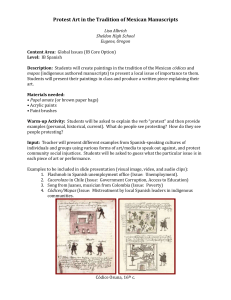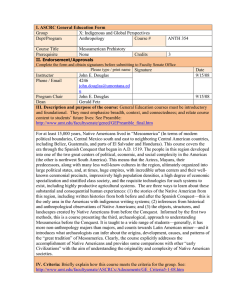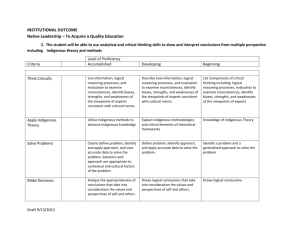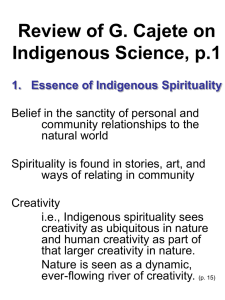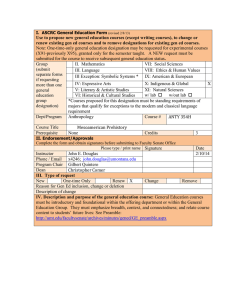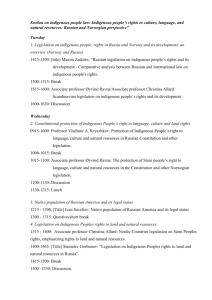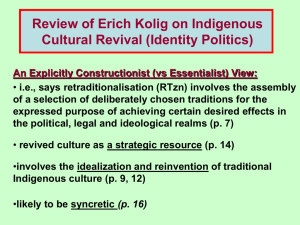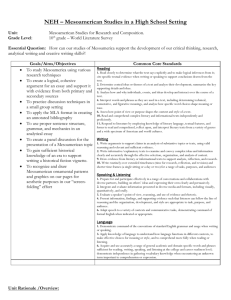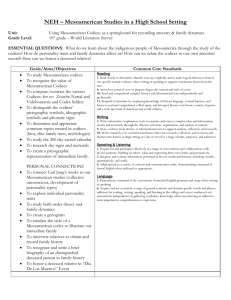"Mesoamerican Cultures and their Histories: Spotlight on Oaxaca
advertisement
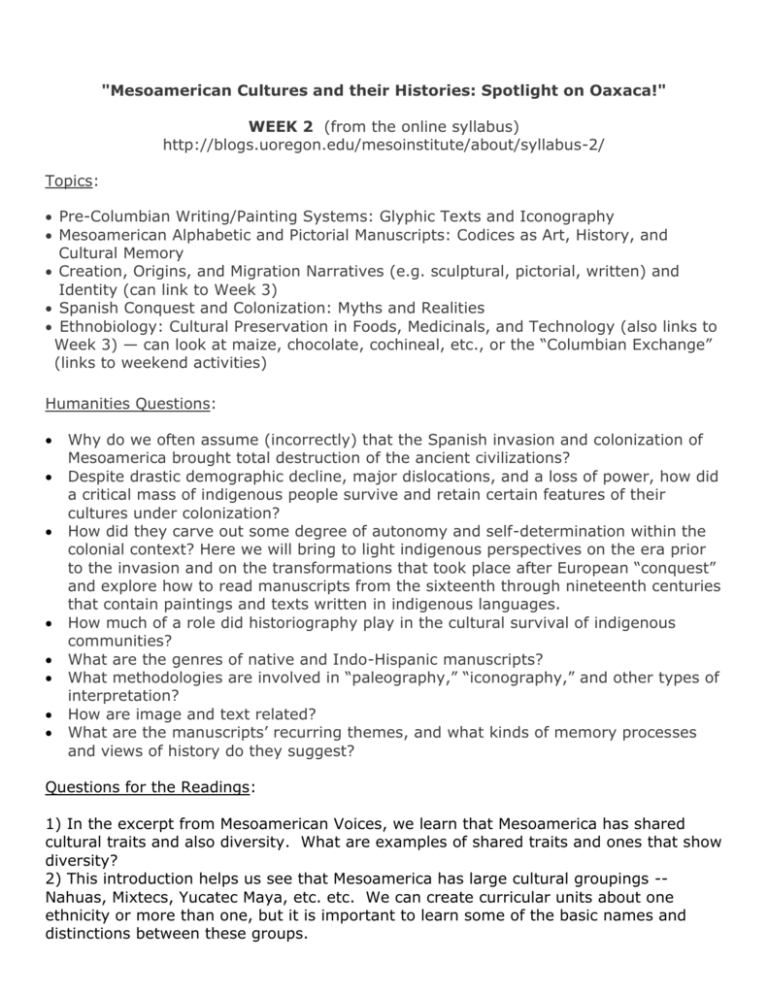
"Mesoamerican Cultures and their Histories: Spotlight on Oaxaca!" WEEK 2 (from the online syllabus) http://blogs.uoregon.edu/mesoinstitute/about/syllabus-2/ Topics: Pre-Columbian Writing/Painting Systems: Glyphic Texts and Iconography Mesoamerican Alphabetic and Pictorial Manuscripts: Codices as Art, History, and Cultural Memory Creation, Origins, and Migration Narratives (e.g. sculptural, pictorial, written) and Identity (can link to Week 3) Spanish Conquest and Colonization: Myths and Realities Ethnobiology: Cultural Preservation in Foods, Medicinals, and Technology (also links to Week 3) — can look at maize, chocolate, cochineal, etc., or the “Columbian Exchange” (links to weekend activities) Humanities Questions: Why do we often assume (incorrectly) that the Spanish invasion and colonization of Mesoamerica brought total destruction of the ancient civilizations? Despite drastic demographic decline, major dislocations, and a loss of power, how did a critical mass of indigenous people survive and retain certain features of their cultures under colonization? How did they carve out some degree of autonomy and self-determination within the colonial context? Here we will bring to light indigenous perspectives on the era prior to the invasion and on the transformations that took place after European “conquest” and explore how to read manuscripts from the sixteenth through nineteenth centuries that contain paintings and texts written in indigenous languages. How much of a role did historiography play in the cultural survival of indigenous communities? What are the genres of native and Indo-Hispanic manuscripts? What methodologies are involved in “paleography,” “iconography,” and other types of interpretation? How are image and text related? What are the manuscripts’ recurring themes, and what kinds of memory processes and views of history do they suggest? Questions for the Readings: 1) In the excerpt from Mesoamerican Voices, we learn that Mesoamerica has shared cultural traits and also diversity. What are examples of shared traits and ones that show diversity? 2) This introduction helps us see that Mesoamerica has large cultural groupings -Nahuas, Mixtecs, Yucatec Maya, etc. etc. We can create curricular units about one ethnicity or more than one, but it is important to learn some of the basic names and distinctions between these groups. 3) How did the Spaniards seize power in Mesoamerica? What factors contributed, giving them an advantage? 4) After gaining power, where did Spaniards settle and why? What were the biggest changes they introduced into the lives of Mesoamericans? 5) How did Mesoamericans find ways to defend their communities from onerous demands of Spanish colonialism? 6) What can we learn from documents authored by indigenous scribes/notaries? 7) Pohl's "The Meeting" summarizes some indigenous sources on the historic encounter between Spaniards and some Nahua groups. Maybe we can take this example as a way of evaluating the strengths of seeing indigenous points of view? 8) Each year, a few NEH Summer Scholars choose to make a curricular unit with Mesoamerican codices (indigenous-authored pictorial manuscripts) as its focus. Pohl's introduction to codices will provide helpful background for this. But this information also highlights what kinds of information these ethnic groups felt important to record for posterity. What is meant by saying the "Mixtec group is basically historical"? What was history in their view? And why would some groups emphasize prophecy? How do writings on hide, paper, or ceramics give us clues about beliefs and ceremonies? Are there human universals in these things? Are there culturally specific features? 9) What are some of the myths of the Spanish Conquest of Mexico that Restall's two chapters highlight for us? Do you find his arguments surprising? credible? 10) Terraciano’s chapter is full of detailed linguistic and historical information. The take away might be the general nature of the transition from pre-Hispanic Mixtec (Ñudzahui) ways to colonial Ñudzahui ways. While some things changed, was their room for some continuity, as well? Also, notice what might be unique in Ñudzahui culture (e.g. the nature of a gender-balanced rule, the “big house” metaphor, “reciprocal labor,” and other things. And try to retain mental images of archaeological sites we have visited when you read about the nature of communities and ruling households. 11) What do you notice about material culture of the Ñudzahui people a generation after Spanish colonization from the 1551 and 1561 excerpts from the Mixtec Codex Sierra (translated into English by Terraciano and Sousa)? What is still indigenous and what do you see that was apparently introduced by the colonizers? And how do the Mexica (Nahuas) enter into activities here in the Mixteca? Notice that this account book is being kept in an indigenous language and how decisions about what to spend for what kinds of purchases are being made by the indigenous town council.

